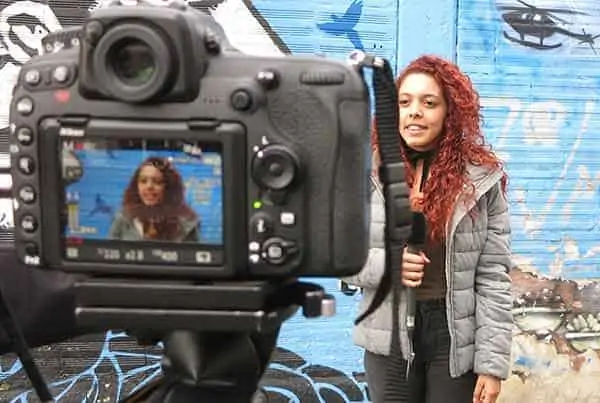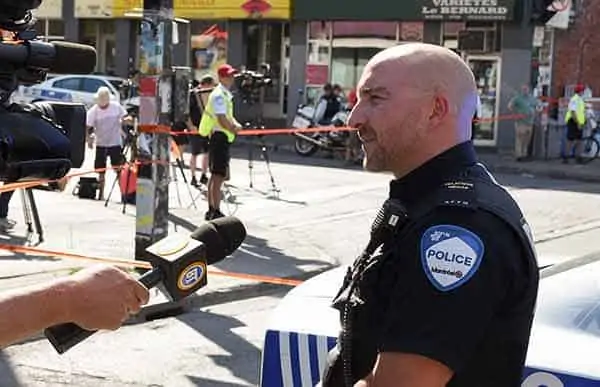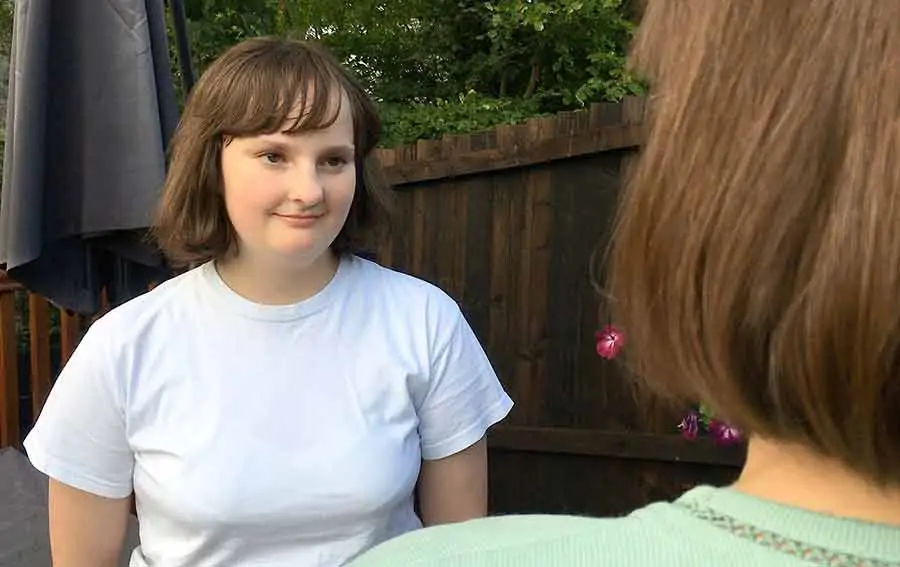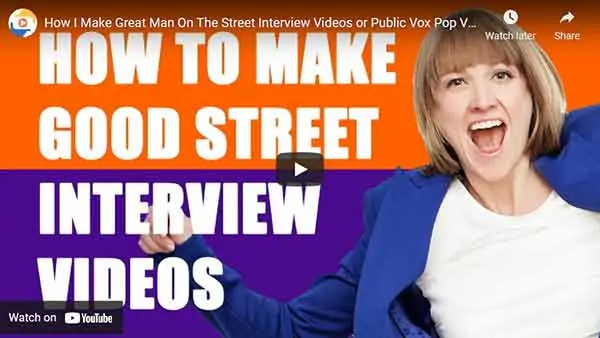DIY Video Studio is supported by its readers. Please assume links on this site are affiliate links or ads, and that I get commissions for purchases made through these links. As an Amazon Associate, I earn from qualifying purchases. Thank you if you use any of the links.
What is a Street Interview Video?
The Vox Pop![]() , Street Interview, or Man in the Street video usually consists of several short interview segments recorded with members of the public. They can be videos in their own right or used within a longer video to add different viewpoints on your subject.
, Street Interview, or Man in the Street video usually consists of several short interview segments recorded with members of the public. They can be videos in their own right or used within a longer video to add different viewpoints on your subject.
This type of video is one of the easiest styles of video to make. Yet it can be amazingly effective, engaging, enlightening, and entertaining.
As the name suggests, an interviewer asks members of the public a question or their opinion on a topic. With the various answers edited together the video, in an unscientific way, gauges the public’s opinion
With street interview videos little scripting is required. The producer and interviewer will consider street interview topics, formulate the appropriate question, and record an appropriate quick intro and maybe an outro for the video

The intro and outro may even be recorded after the street interviews have been completed. All of these can be improvised on location
Usually, many people will be asked the same question. It can be serious or light-hearted. The street interview does not have a single fixed tone that must be adhered to. The videos can equally sit in a news or entertainment strand.
Man on the street interview tips
The first thing you need is the right location. It must be somewhere with a reasonable volume of foot traffic to get enough people to speak to you.
But the location should also be appropriate to your topic or provide an interesting backdrop. For instance, if you are doing a street interview about a pigeon nuisance you might want to record where pigeons gather. That might be a park or public square.
If you want somewhere with a high footfall, you might initially think a shopping mall might be suitable. However, ensure you have permission in advance since they are usually private property
In the past, I tried conducting street interviews in a local shopping mall, but I was swiftly ejected by security guards. Usually, it will be on safety grounds. When filming you may cause a crowd to gather and that may cause an obstruction and a hazard
A better location would be on a public street or an open area where you will not cause an obstruction or inconvenience to others. Naturally, you also want a location that is unlikely to be a danger to your or your interview subjects.
Conventions and EXPOs are also suitable places to record street interview videos. Obviously, you’re not on the street but instead, grab people as they wander around the exhibition hall or standing in front of their stand.
Get some help and look the part
Although it is possible to record the video all by yourself, and I have done it, it is advantageous to have an assistant. For a start, the public will view you as being more credible if you look like their perception of a TV reporter with a camera operator
I try to look the part, even when filming on my own. If I look right to other people, it gives me a little authority and even helps to build trust. The result is that I can get away with asking questions people would normally ignore from strangers.
So, what do I do
Dress like a professional, so no jeans or sweatpants
I use a professional looking microphone that has a branded microphone flag on it. It looks just like those mics that radio and TV reporters make sure they get into news clips. It does not matter whether your YouTube channel has one or one million subscribers, get your logo onto a mic flag so people can see it.
I also have a name badge on my lapel or shirt. It does not say “PRESS”, in fact, it’s my business card in a plastic holder, but it looks official. Because I look the part, the people I stop and speak to usually cooperate.
The other big advantage of having an assistant is that they can operate the camera, or the phone’s camera app, freeing me (or you) to engage with the public. They often forget about my assistant and just talk to me. I get better results more quickly.
Handheld camera or tripod mounted
The camera, or phone, can either be hand-held, on a gimbal or mounted on a tripod. Your choice will determine the look and feel of the video.
A tripod will give a solid and more formal look to your video. Whereas a handheld camera will give your video a less formal and more natural feel. Using a handheld camera would also allow you to add movement, making the video more dynamic and seemingly faster-paced.
Unless you really are after a grungy aesthetic mount your camera on a gimbal for silky smooth movement. Lots of jerky camera movement can look unpleasant and be distracting
Personally, I use my pro video camera on a tripod when the event is more formal or there is plenty of space. Meanwhile, for smaller venues or where I want to be part of the action on screen, I’ll use an iPhone on my DJI OSMO mobile. This setup is not suited to plugging a pro microphone into my iPhone, so I record the sound separately on a Zoom digital audio recorder.
The Zoom H5 recorder has XLR inputs, making it easy to plug in a decent quality reporters’ microphone. However, since Zoom Handy recorders have a pair of built-in microphones at one end, I have effectively used the recorder as a handheld microphone
![]() here on Amazon.
here on Amazon.
Framing the shot
The camera lens should be at or just a little below the interviewee’s eye-level
The answers are being addressed to you, the interviewer, and not the viewer, so have the interviewee look at you
You can appear in the shot with the interviewee, but my preference is to concentrate on the interviewee. Therefore, stand to one side of your camera and have the interviewee look at you, not the camera lens
Frame the shot so the interviewee is slightly off to one side but gazing roughly towards the other side of the frame. Depending on your camera, either move in or use your zoom to frame the person in a Close-Up. This maximizes their screen presence, making their contribution seem more intimate, personal, and powerful.

With each new interviewee place them on the opposite side of the frame to the previous person. The alternating perspective can give you more visual interest in the edit. The easiest way to achieve this is by moving the camera to your other side. You will also get a slightly different perspective of your location backdrop, keeping the scene looking fresh and interesting for the viewer
More engagement with the public
If you are working on your own, or want to engage with your interview subject, get in close and shoot selfie-style. Stand close, or even beside your interviewee. But remember some people may feel uncomfortable suddenly getting so close to a stranger. If you are using an iPhone or DSLR/mirrorless camera, hold it at arm’s length. An iPhone can be attached to a selfie stick to give you a wider shot.
If you’re a vlogger the selfie stick method will probably be your preferred choice because it keeps you in the frame and involved. However, this time, always keep your interviewees on the same side of you but choose a slightly different spot to shoot each clip. This way the background changes at each cut.
Mix it up
If you’re dealing with an issue that concerns everyone, mix up the gender and social profile of the people you approach. That way, your street interview will appear more representative of the whole community. Obviously, if you have a niche audience or your question is relevant only to certain people, you might only want to speak to that type of person.
Man on the street interview microphone
In a street interview, you may get away with using the internal microphone on your camera or iPhone. That is because the camera is going to be close to you. However, the most important thing you need to get right on the technical side of recording is the sound. If the viewer cannot hear what is being said, they are not going to continue watching.
The street interview is one video where you can use a handheld microphone to great effect. I would advise using a handheld cardioid microphone

Excellent quality reporter microphones can be expensive but there are many workable alternatives available. Look on Amazon for the rugged Shure M58![]() or much cheaper Movo HM-M2 Handheld Interview Microphone
or much cheaper Movo HM-M2 Handheld Interview Microphone![]() . Both can work a treat in street interviews, helping to give you much better sound quality and reduce background noise.
. Both can work a treat in street interviews, helping to give you much better sound quality and reduce background noise.
If you want to know more about microphones check out my article![]() on dynamic and condenser microphones. If background noise is an issue where you are recording, look at my article on recording better sound in a noisy environment
on dynamic and condenser microphones. If background noise is an issue where you are recording, look at my article on recording better sound in a noisy environment![]() .
.
Last update on 2025-10-20 / Affiliate links / Images from Amazon Product Advertising API
How to approach strangers for interviews
When it comes to getting members of the public to speak on camera have a standard way of approaching them. One possibility is, “Could I ask you a couple of questions about alternative energy to go onto the Street TV YouTube channel?” Of course, change the channel name to your own.
Most people you approach will have never been interviewed before so be reassuring. But do not give them lots of time to worry about their appearance or how they sound.
The less time they have to think and worry the more natural they will appear on the video. If you want to be quite official about permission, get them to sign a release form. That will give you permission to use their contribution. Once they agree to take part just get on with the recording.
Start with a good idea
I have said it before, and I will say it again, do not wing it. A video is like any other thing in life, it is always better if you have prepared in advance. When I have gone out hoping something might just happen at an event, that’s when my video ends up like garbage. Although the questions can be on any topic do not think it will just happen. Know what you want to talk about, have a plan, and execute it.
You could try looking for a reaction to a prominent issue of the day. If you are going down the funny video route, why not prepare a strange or odd question. Say it’s a sizzling summer and there’s a great ice cream parlor close by. Grab people and ask them what flavor they would buy for their partner and why.
Serious or fun, the possibilities are endless when you start with an idea.
The correct street interview questions to ask
Ask open questions that require a longer answer with more depth. These will help get responses that show how the person feels or thinks about the issue.
Typically, these questions will start with, “What”, “Who”, “How”, “Why”, and “Where”. For example, “What do you think will happen if we continue using fossil fuels?”, “How is global warming going to affect Scotland?” or “What were the benefits of installing solar panels?”
What you don’t want to do is ask closed questions that could be answered with a yes or a no. So, our previous questions as closed questions might be, “Will it be a problem if we continue to use fossil fuels?”, “Will global warming affect Scotland?” and “Have you seen a benefit after installing solar panels?” The answers will be “yes”, “no” or perhaps, “I don’t know”. Not what you normally will want, but not always. Perhaps you’re outside a sports stadium you could ask, “Who’s going to win?” Then single-word answers from passionate fans could be quite fun, but perhaps keep that question as a follow-up to your main one.
If you intend your street interview video to be light-hearted, try catching your interviewees off guard. Ask them a question they are not expecting because their reaction could well be hilarious. For instance, if you are at a soccer convention you could ask, “What’s the worst goal you’ve ever seen?”
The surprise is the key
The key to getting some great material in a man-on-the-street video is not to warn your subject about the exact detail of your questions. Even better, introduce an unrelated question that will catch your interviewee off-guard.
Without time to think, they will be spontaneous, revealing, and entertaining. If the questions and answers are quite contentious you may even spark a strong reaction from your viewers and stimulate a sizeable number of comments and lively debate.
You are not done once they have answered your questions
Once your interviewee has answered the final question keep recording for a second or two. Those extra seconds will be useful when you come to edit your footage. Now ask them their name and how to spell it. That way, if you introduce them or have their name on a lower third, you’ll have the correct pronunciation and spelling.
Strictly speaking, you should get your contributors to complete and sign a consent or release form. Often a verbal OK is enough, but it is always better to get their written permission to use their contribution. If the material is to be broadcast a signed consent form is essential.
Monitor the sound
To ensure you record good sound make sure you monitor the recording on headphones. Use the type that closes around your ears, so you can clearly hear what’s being recorded. If you are recording on a busy street you need to know whether buses and trucks are drowning out what your contributors are saying.
Maximize your productivity
Good video production is not something that just happens. It takes time and a lot of planning. Therefore, it is sensible to maximize your productivity when you are out on location.
You may have one topic in mind but be prepared and ask two or three questions on different topics. When you come to edit you can have two or three different street interview videos from the one location shoot.
This is what I frequently do at business shows and EXPOs around the UK. It only takes me a few minutes more, but it multiplies the number of finished videos I can supply to my client.
How much footage should you shoot?
The truthful answer to the question is, “more than you think you will need”. In fact, much more. If you want to end up with a good two-minute man-on-the-street interview video, you will need to shoot many minutes of interviews
Be brutal with your editing
Unless you have some truly outstanding answers, most street interview videos should be about two or three minutes. When editing the footage, keep the most interesting, controversial, or funniest comments. The rest should be ditched, never to be seen again. Only keep the best material.
It is always better to have a shorter but funnier or more powerful video than one that goes on and on with OK type footage. Longer is not necessarily better when a shorter video can have more impact and leave your viewer wanting more.
When editing you should keep the video rolling on forward by cutting out the gaps between interviewees. To drive the video forward and make it more dynamic keep each response short. In so doing, the viewer will be gripped and will keep watching.
After a few responses don’t forget to slip in your question again. It helps you refocus the topic of the video for the viewer and act as a kind of pause for breath if the pace is getting too manic
Don’t be afraid to laugh at yourself
I don’t mind if things go wrong while I’m recording. I’ll keep the material and use it where appropriate. Generally, the viewer likes to see what has gone wrong or where I make a complete ass of myself
Making this type of content is a wonderful way of gaining confidence if you think you are going to suffer from presentation nerves. With the man in the street interview genre, you don’t have to do much speaking. You just ask questions and let others do the talking. But if you do suffer from presentation nerves you may like to read this article of mine.
Summary of tips for street interview videos
#1. Choose the right location
Record at or near a busy public location, such as a street. But make sure it is not too noisy. Since you will get lots of rejections, a busy location increases your chance of getting enough people to record.
#2. Try to get spontaneous answers
Don’t give your contributors too much time to think of an answer. The unexpected question will get a spontaneous answer that is more interesting, revealing, or entertaining
#3. Know how to approach the public
Tell each person why you want to ask them a few questions and what you intend to do with the recordings. Once you have finished recording get them to complete and sign a consent or release form.
#4. Record quality sound
Use a handheld microphone close to the contributor to ensure they are louder than the background noise. Make sure someone is monitoring the recording on headphones to catch any problems early on.
#5. Get the framing right
The way you frame your contributors will be determined by your house style. However, close-up shots make them look more personal and engaged.
#6. Ask open-ended questions
Make your questions open-ended, so that people give you more than a yes or no answer. Always ask the same question.
#7. Record more material than you think you will need
Some contributors will never make it to the final cut, so make sure you have as much material as possible. The more people you can speak to the better.
#8. Keep things visually interesting
Change your angles and the backdrop to keep the visuals as interesting as the answers.
Tosh Lubek runs an audio and video production business in the UK and has been using the Canon EOS R since it was released in the Autumn of 2018 and the Canon EOS R6 in 2020. He has used both cameras to shoot TV commercials broadcast on Sky TV, promotional business videos, videos of events and functions, and YouTube creator content. He has also won several international awards for his advertising and promotional work. You can meet him by visiting his “video booth” at HashTag Business Events across the country.
Recent Posts
Most people use sandbags the wrong way. Here’s how to hang them properly on a light stand for maximum stability and safety — plus what to fill them with.
You're Using the Canon RF 50mm f/1.8 WRONG! Here’s How to Fix It
If you’ve recently picked up the Canon RF 50mm f/1.8 STM—affectionately known as the Nifty Fifty—you might be confused by that strange switch on the side of the lens. It doesn’t say AF/MF...






